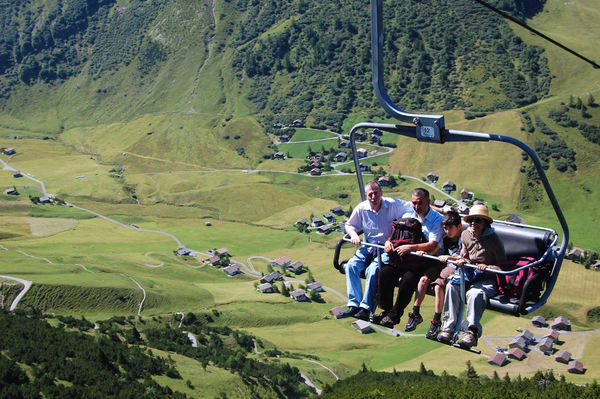Little, Little Liechtenstein
By Rick Steves
Two centuries ago, there were dozens of independent states in the part of Europe that was German-speaking. Today, there are only four: Germany, Austria, Switzerland…and Liechtenstein.
I like the way tiny countries are defined so clearly by geography. Liechtenstein's eastern border traces high ridges with Austria at their backs, with the milky baby Rhine River — still giddy from its tumble out of the Alps — running south to north on its western border with Switzerland, and the stout and classic Gutenberg Castle guarding entry on the south. The nation is doubly landlocked (you'd have to cross at least two borders to reach the sea), and even lacks an airport.
The place is low on quaint villages — visitors here find themselves mostly among shiny bank buildings and office parks. Like most other tiny nations of Europe, Liechtenstein survives in part by offering businesses special tax and accounting incentives. For a place with such a small population (40,000), Liechtenstein hosts a lot of businesses.
And that's how the Prince of Liechtenstein, whose 13th-century castle is perched fairy-tale style above his domain, likes it. The billionaire prince, who looks down on his roughly 4-by-15-mile country, doesn't open his castle to the public. When I knocked on the door, the guard looked at me like I was nuts. But anyone can enjoy his views. And, for a price, you can enjoy a glass of local wine in his wine cellar.
Prince Hans-Adam II is one of Europe's wealthiest heads of state, largely thanks to having transformed his family's local bank into a global financing group (well before he took the throne in 1984). He was in the news in the early 2000s for threatening to actually abandon his principality if his citizens didn't give him more political power. Liechtensteiners seem pretty easygoing about these things (women didn't claim the right to vote until 1984) and accepted his demands. Now the Prince of Liechtenstein arguably wields more real authority than any other royal in Europe. (But you can't do a lot with that power when you're ruling a country with the population of Yankee Stadium on an off day.)
Liechtenstein is made up of 11 villages. The village of Triesenberg, perched above the valley, gathers around its onion-domed church, which recalls the settlers who arrived here centuries ago from the western part of Switzerland. The town of Vaduz sits on the valley floor. While it has only 6,000 people, it's the country's capital. Its pedestrianized main drag is lined with modern art and hotels, and borders a district of slick office buildings. There's so little of interest to tourists in Liechtenstein that souvenir shops stock as many books and postcards on Switzerland as they do on Liechtenstein.
The pint-sized national museum tells the story of the prince and his tiny country. Their family crest dates to the Middle Ages, when the Liechtenstein family was close friends with the Habsburg family, who ruled the Holy Roman Empire. The House of Liechtenstein purchased this piece of real estate from the Holy Roman Emperor. In 1719, the domain was granted principality status — answering only to the Emperor. The Liechtenstein princes — who lived near Vienna — saw their new country merely as a status symbol, and didn't even bother to visit for decades. In fact, it wasn't until the 20th century that the first Liechtenstein prince actually lived in Liechtenstein. (That's why the art-packed Liechtenstein Palace — the most exciting sight associated with that family — isn't in Liechtenstein, but hours away in in Vienna.)
In 1806, during the age of Napoleon, Liechtenstein's obligations to the Habsburg Emperor disappeared and it was granted true independence. Later, after World War I, tough times forced the principality to enter an economic union with Switzerland. To this day, Swiss francs are the coin of the realm, most public transportation is on Swiss postal buses, and Liechtenstein enjoys a close working relationship with its Swiss neighbors.
A big part of the principality's modern economy, like Switzerland's, is about drawing visitors to enjoy its dramatic natural beauty. Ski lifts, busy both in winter and summer, take nature-lovers to the dizzying ridge that serves as the border with Austria. It's reachable via Liechtenstein's longest road, which peters out in the tiny mountain resort of Malbun.
All of little, little Liechtenstein lies on or downhill from this west-facing mountainside, so virtually everything here is in shade well into the morning — and bathed in fading light at the end of the day. On the evening of my most recent visit I crossed the Rhine back into Switzerland, and snooped around to find the perfect vantage point from which to capture the entire country in one wide photo — and enjoyed the rare experience of watching the sun set over a country I had toured, quite thoroughly, in a single day.

